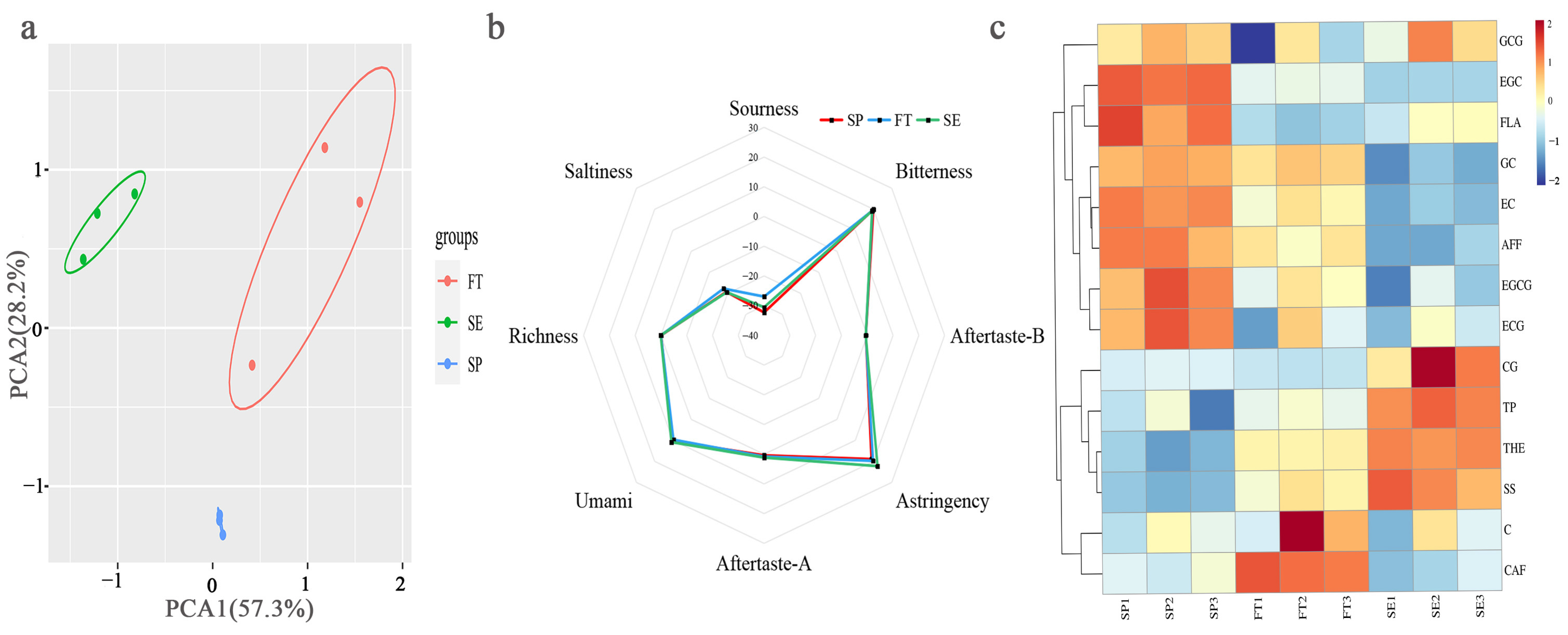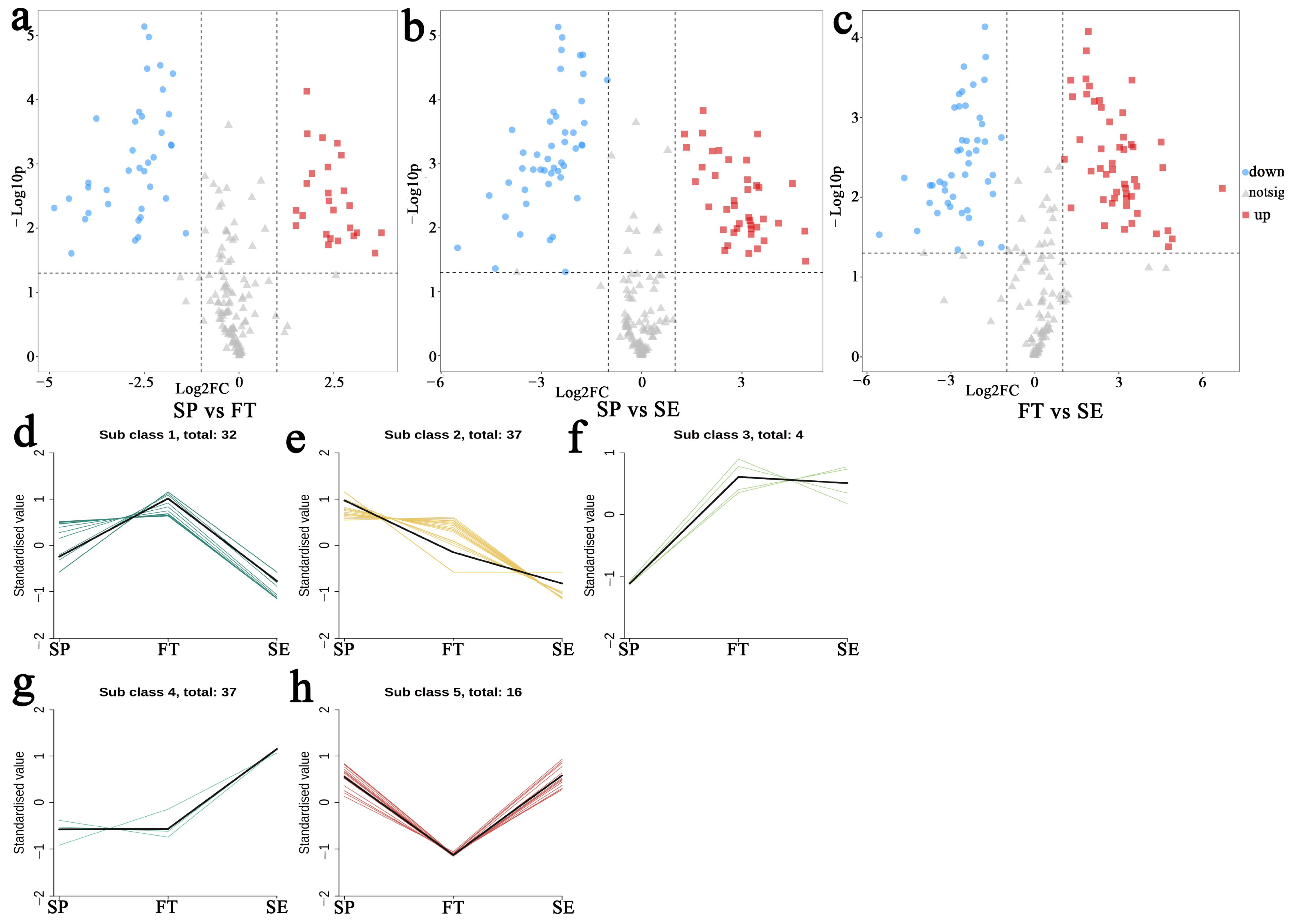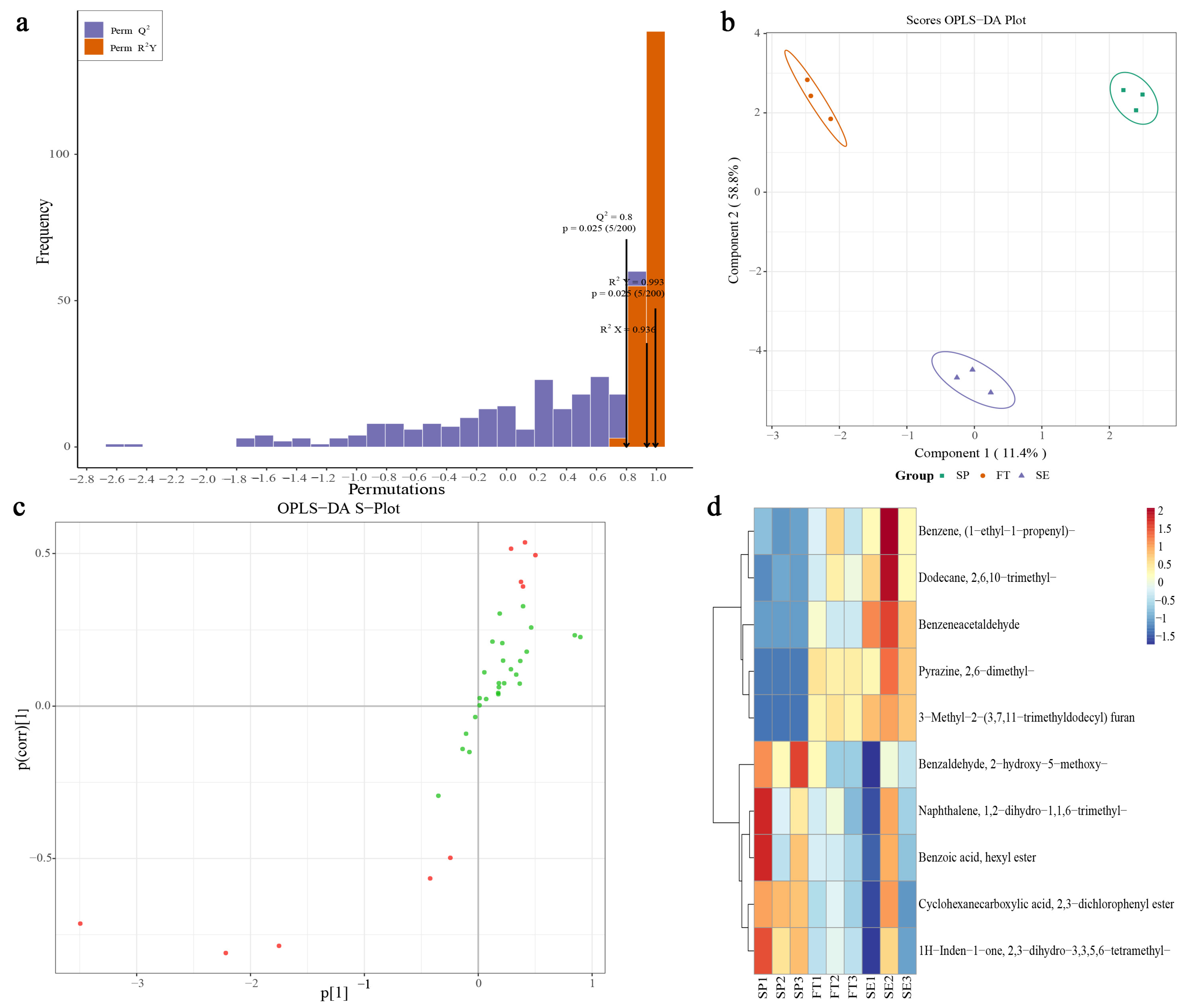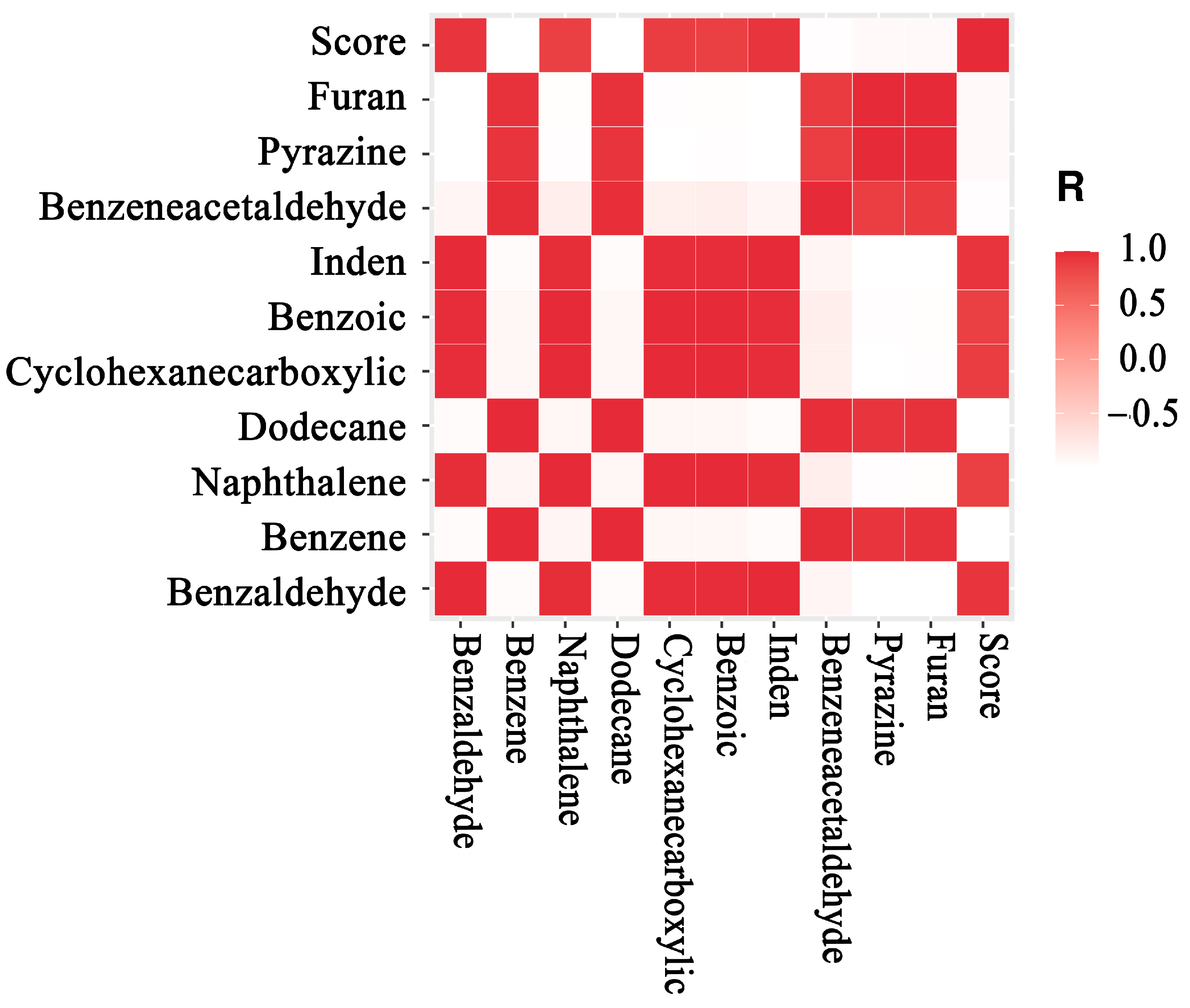Research on Taste and Aroma Characteristics of Dahongpao Tea with Different Grades
Abstract
1. Introduction
2. Materials and Methods
2.1. Sample Collection
2.2. Experimental Reagents
2.3. Sensory Evaluation
2.4. Electronic Nose Analysis
2.5. Electronic Tongue Analysis
2.6. Biochemical Component Analysis
2.7. HS-SPME-GC-MS Analysis
2.8. Statistical Analysis
3. Results and Discussion
3.1. Sensory Evaluation and Electronic Nose Analysis of Dahongpao of Different Grades
- The sensory evaluation of Dahongpao tea samples of different grades (Figure 1a, Table S1) revealed significant differences in appearance, soup color, aroma, taste, and leaf bottom. Across these five sensory attributes, quality was consistently ranked as SP (special grade) > FT (first grade) > SE (second grade). The average total sensory scores were 94.15 for SP, 85.2 for FT, and 75.95 for SE. Notably, in the sensory evaluation of Wuyi rock tea, aroma and taste were the most influential factors, contributing 30% and 35% to the total score, respectively. This indicates that variations in aroma and taste were the primary determinants of grade differences in Wuyi rock tea;
- Electronic nose analysis of Dahongpao tea samples from different grades (Figure 1b,c, Table S2) further supported these findings. The principal component analysis (PCA) of aroma components showed a clear distinction between grades, with PCA1 accounting for 81.1% of the variation and PCA2 for 18.6%. Significant differences were observed in the response values of sensors S2, S8, and S10, which were associated with nitrogen oxides, alcohols, and esters. The concentration of these compounds followed SP > FT > SE of the trend, indicating higher levels of aroma-active alcohols and esters in higher grade teas;
- Previous studies have shown a strong correlation between floral and fruity aromas in Wuyi rock tea and the presence of alcohols and esters [12,21]. This suggests that higher concentrations of these volatile compounds in SP contribute to its more pronounced floral and fruity notes, ultimately leading to higher aroma scores.
3.2. Electronic Tongue and Quality Index Analysis of Dahongpao of Different Grades
- The taste of tea soup is a significant factor in the sensory evaluation of Wuyi rock tea, with its quality closely related to the chemical composition of tea. Electronic tongues, extensively used for quality analysis of liquid foods, have proven effective in distinguishing grade differences between teas [5,22,23];
- The analysis of Dahongpao samples of different grades using an electronic tongue is illustrated in Figure 2 and Table S3. Figure 2a demonstrates that the electronic tongue effectively differentiates taste profiles among the grades. Principal component analysis (PCA) revealed that PCA1 accounted for 57.3% of the variance, while PCA2 accounted for 28.2%. Higher-grade Dahongpao teas exhibited increased bitterness yet showed reduced levels of Aftertaste-B, astringency, and Aftertaste-A;
- Quality index analysis revealed that higher-grade Dahongpao had a higher catechins content, while lower-grade teas contained more tea polyphenols. Previous studies have shown that caffeine, tea polyphenols, and catechins significantly influence the bitterness and astringency of oolong tea [24,25]. These findings suggest that higher-grade Dahongpao teas possess a more intense taste profile, with bitterness and astringency dissipating more readily, contributing to a higher sensory evaluation score for taste.
3.3. Analysis of Volatiles in Dahongpao of Different Grades
- A comprehensive analysis of 210 volatile compounds in Dahongpao of various grades was conducted using GC-MS. The identified compounds included alcohols (14 types), amines (10 types), aromatic hydrocarbons (9 types), phenols (5 types), aldehydes (16 types), carboxylic acids (8 types), terpenes (13 types), ketones (20 types), alkanes (8 types), esters (47 types), and alkenes (16 types) (Figure 3a). Among these, FT had the greatest diversity in aroma components, with 44 unique compounds, while SE had 17 and SP had only 6 (Figure 3b);
- Principal component analysis (PCA) revealed that SP and FT had similar aroma profiles, as they occupied the same quadrant in the PCA plot, whereas SE was clearly separated (Figure 3c). This suggests that while SP and FT share some common aroma characteristics, SE has a markedly different profile. The analysis further indicated that terpene compounds were the most abundant across all grades, followed by esters, aldehydes, and ketones (Figure 3d);
- To further explore the quality differences between Dahongpao grades, a cluster analysis based on heatmap was performed on aroma components. The results highlight a notable enrichment of terpenes, esters, and alkenes in SP (Figure 3e). Previous studies reported that terpenes and esters contribute fruity, floral, or sweet aromas to oolong tea [26]. Specifically, terpenes are associated with floral, fruity, and woody characteristics [27], while alkenes are associated with green, floral, or fruity notes [28,29]. SP was particularly rich in terpenes with floral and fruity aromas, such as β-myrcene, cyclohexene, and α-farnesene [29,30,31,32]. FT also contained ketones with floral and fruity notes, including 3,5-octadien-2-one and bicyclo[3.3.1]nonan-2-one [33,34]. SE featured ester compounds with similar floral and fruity aromas, such as ethyl 2-(5-methyl-5-vinyltetrahydrofuran-2-yl)propane-2-yl carbonate and phthalic acid butyl hept-3-yl ester [35,36,37,38,39,40,41];
- In summary, the analysis indicates that Dahongpao of different grades has significant variations in volatile compounds, with the highest concentration of terpenes, followed by esters and ketones. These compounds are closely related to floral and fruity characteristics. Differences in aroma profiles between grades were evident; however, further research was deemed necessary to identify and characterize the key volatile compounds responsible for these differences.
3.4. Screening of Different Volatiles
- To identify volatile compounds that differentiate Dahongpao of various grades, a volcano plot was employed to analyze the relative abundance of volatiles across grades. The analysis revealed that SP had 119 up-regulated and 57 down-regulated volatile compounds compared to FT. Conversely, FT showed 74 up-regulated and 116 down-regulated compounds when compared to SE (Figure 4a,b);
- Further analysis using K-means clustering on the relative content changes of volatile metabolites across grades demonstrated distinct patterns (Figure 4c–g). The first subclass showed a relationship of SP ≈ FT < SE, primarily involving compounds that did not fit into the categorized groups. The second subclass and third subclass exhibited SP > FT > SE and SP > FT ≈ SE, respectively. This latter analysis identified a total of 41 substances, predominantly esters and terpenes with fruity and floral aromas. Notable compounds included hexanoic acid, tridec-2-ynyl ester, phthalic acid di(2-phenylethyl) ester, benzoic acid-hexyl ester, cyclohexanecarboxylic acid, 2,3-dichlorophenyl ester, β-myrcene, cyclohexene, 3-methyl-6-(1-methylethenyl)-(3R-trans)-, and α-farnesene;
- These findings highlight substantial differences in volatile profiles among Dahongpao grades, with specific esters and terpenes contributing significantly to differentiation. This analysis underscores the importance of these compounds in distinguishing between different grades of Dahongpao tea;
- Further analysis using OPLS-DA was conducted to identify differential substances within the first, second, and third subclasses. The results indicate that after 200 random simulations, the model demonstrated high goodness of fit (R2Y = 0.993, p < 0.025) and predictability (Q2 = 0.8, p < 0.025), suggesting robust performance (Figure 5a). The model effectively distinguished between different samples, with component 1 accounting for 11.4% of the variance and component 2 accounting for 58.8%, supporting its usefulness for further analysis (Figure 5b);
- S-Plot analysis of the OPLS-DA model identified differential substances with VIP values > 1, resulting in the screening of 10 key compounds (Figure 5c,d). Among these, substances with the highest content in SP included benzaldehyde (2-hydroxy-5-methoxy), benzoic acid hexyl ester, cyclohexanecarboxylic acid, 2,3-dichlorophenyl ester, 1H-Inden-1-one, and 2,3-dihydro-3,3,5,6-tetramethyl, all noted for their fruity and floral aromas [32,42]. Additionally, naphthalene (1,2-dihydro-1,1,6-trimethyl) contributes a woody aroma [43]. In contrast, SE was characterized by higher levels of benzene (1-ethyl-1-propenyl), dodecane (2,6,10-trimethyl), pyrazine (2,6-dimethyl), benzeneacetaldehyde, and 3-methyl-2-(3,7,11-trimethyldodecyl) furan, which are associated with floral, roasted, or nutty flavors [44,45,46]. The high abundance of hexyl benzoate in SP (Figure 5d) aligned with its low odor threshold [25], which amplified floral perception even at trace concentrations. This mechanistic link explains the superior aroma scores of superfine-grade tea;
- The correlation analysis (Figure 6) indicated that compounds such as benzaldehyde (2-hydroxy-5-methoxy), benzoic acid hexyl ester, cyclohexanecarboxylic acid 2,3-dichlorophenyl ester, 1H-inden-1-one (2,3-dihydro-3,3,5,6-tetramethyl), and naphthalene (1,2-dihydro-1,1,6-trimethyl) showed a significant positive correlation with sensory evaluation scores (p < 0.05). This suggests these compounds are closely associated with enhancing the sensory attributes of the evaluated samples. Conversely, benzene (1-ethyl-1-propenyl), dodecane (2,6,10-trimethyl), pyrazine (2,6-dimethyl), benzeneacetaldehyde, and 3-methyl-2-(3,7,11-trimethyldodecyl) furan were significantly negatively correlated with sensory scores (p < 0.05). This suggests these compounds are critical in influencing the aroma profile of Dahongpao;
- Baking is a crucial processing step for Wuyi rock tea, inducing Maillard reactions that impact tea quality [47]. Research by Lin et al. [12] indicated that lower-grade Wuyi Shuixian tea often exhibits more pronounced baking and sweet flavors. Similarly, this study found that lower-grade Wuyi Dahongpao contained higher levels of nutty and roasted compounds, likely due to Maillard reactions during baking, which affect the tea’s aroma components;
- In summary, the aroma profiles of Dahongpao across different grades vary significantly. Higher-grade Dahongpao is enriched with esters and aromatic hydrocarbons, contributing fruity, floral, and woody aromas. In contrast, lower-grade Dahongpao contains more alkanes, pyrazines, and furans, imparting floral, roasted, and nutty flavors.
4. Conclusions
Supplementary Materials
Author Contributions
Funding
Institutional Review Board Statement
Informed Consent Statement
Data Availability Statement
Conflicts of Interest
References
- Wang, J.; Li, M.; Wang, H.; Huang, W.; Li, F.; Wang, L.; Ho, C.T.; Zhang, Y.; Zhang, L.; Zhai, X.; et al. Decoding the specific roasty aroma Wuyi rock tea (Camellia sinensis: Dahongpao) by the sensomics approach. J. Agric. Food Chem. 2022, 70, 10571–10583. [Google Scholar] [CrossRef] [PubMed]
- Zhang, S.; Yang, Y.; Cheng, X.; Thangaraj, K.; Arkorful, E.; Chen, X.; Li, X. Prediction of suitable brewing cuppages of Dahongpao tea based on chemical composition, liquor colour and sensory quality in different brewing. Sci. Rep. 2020, 10, 945. [Google Scholar] [CrossRef] [PubMed]
- Chen, Q.; Zhao, J.; Vittayapadung, S. Identification of the green tea grade level using electronic tongue and pattern recognition. Food Res. Int. 2008, 41, 500–504. [Google Scholar]
- He, W.; Hu, X.; Zhao, L.; Liao, X.; Zhang, Y.; Zhang, M.; Wu, J. Evaluation of Chinese tea by the electronic tongue: Correlation with sensory properties and classification according to geographical origin and grade level. Food Res. Int. 2009, 42, 1462–1467. [Google Scholar]
- Ren, G.; Li, T.; Wei, Y.; Ning, J.; Zhang, Z. Estimation of Congou black tea quality by an electronic tongue technology combined with multivariate analysis. Microchem. J. 2021, 163, 105899. [Google Scholar] [CrossRef]
- Zhai, X.; Zhang, L.; Granvogl, M.; Ho, C.T.; Wan, X. Flavor of tea (Camellia sinensis): A review on odorants and analytical techniques. Compr. Rev. Food Sci. Food Saf. 2022, 21, 3867–3909. [Google Scholar] [CrossRef]
- Capone, S.; Tufariello, M.; Francioso, L.; Montagna, G.; Casino, F.; Leone, A.; Siciliano, P. Aroma analysis by GC/MS and electronic nose dedicated to Negroamaro and Primitivo typical Italian Apulian wines. Sens. Actuat. B Chem. 2013, 179, 259–269. [Google Scholar] [CrossRef]
- Aghili, N.S.; Rasekh, M.; Karami, H.; Edriss, O.; Wilson, A.D.; Ramos, J. Aromatic fingerprints: VOC analysis with E-nose and GC-MS for rapid detection of adulteration in sesame oil. Sensors 2023, 23, 6294. [Google Scholar] [CrossRef]
- Wilson, K.C.; Clifford, M.N. (Eds.) Tea Cultivation to Consumption; Chapman and Hall: London, UK, 1992; pp. 603–647. [Google Scholar]
- Yang, P.; Wang, H.; Cao, Q.; Song, H.; Xu, Y.; Lin, Y. Aroma-active compounds related to Maillard reaction during roasting in Wuyi Rock tea. J. Food Compos. Anal. 2023, 115, 104954. [Google Scholar]
- Wang, B.; Yu, M.; Tang, Y.; Wang, Y.; Xia, T.; Song, H. Characterization of odor-active compounds in Dahongpao Wuyi Rock Tea (Camellia sinensis) by sensory-directed flavor analysis. J. Food Compos. Anal. 2023, 123, 105612. [Google Scholar]
- Lin, Y.; Huang, Y.; Liu, X.; Pan, Y.; Feng, X.; Guo, H.; Li, X.; Tao, Y.; Chen, P.; Chu, Q. Uncovering the Shuixian tea grades hierarchy in Chinese national standard: From sensory evaluation to microstructure and volatile compounds analysis. Food Chem. 2024, 459, 140342. [Google Scholar] [CrossRef] [PubMed]
- General Administration of Quality Supervision, Inspection and Quarantine of the People’s Republic of China. GB/T 23776-2018; Methodology for Sensory Evaluation of Tea. China Standards Press: Beijing, China, 2018; pp. 1–28. (In Chinese)
- Xia, H.; Chen, W.; Hu, D.; Miao, A.; Qiao, X.; Qiu, G.; Liang, J.; Guo, W.; Ma, C. Rapid discrimination of quality grade of black tea based on near-infrared spectroscopy (NIRS), electronic nose (E-nose) and data fusion. Food Chem. 2024, 440, 138242. [Google Scholar] [CrossRef] [PubMed]
- General Administration of Quality Supervision, Inspection and Quarantine of the People’s Republic of China. GB/T 8313-2018; Determination of Tatal Polyphenols and Catechins Content in Tea. China Standards Press: Beijing, China, 2018; pp. 1–8. (In Chinese)
- General Administration of Quality Supervision, Inspection and Quarantine of the People’s Republic of China. GBT23193-2017; Determination of Theanine in Tea-Usiing High Performance Liquid Chromatography. China Standards Press: Beijing, China, 2017; pp. 1–8. (In Chinese)
- General Administration of Quality Supervision, Inspection and Quarantine of the People’s Republic of China. GB/T 8314-2013; Determination of Total Free Amino Acids. China Standards Press: Beijing, China, 2017; pp. 1–5. (In Chinese)
- General Administration of Quality Supervision, Inspection and Quarantine of the People’s Republic of China. GBT8312-2013; Tea-Determination of Caffeine Content. Method Using High-Performance Liquid Chromatography. China Standards Press: Beijing, China, 2013; pp. 1–5. (In Chinese)
- Wang, H.B.; Lin, L.W.; Wang, Y.H. Technical Specification for Tea Production, Processing and Safety Inspection; Xiamen University Press: Xiamen, China, 2020. [Google Scholar]
- Hu, W.; Wang, G.; Lin, S.; Liu, Z.; Wang, P.; Li, J.; Zhang, Q.; He, H. Digital evaluation of aroma intensity and odor characteristics of tea with different types—Based on OAV-splitting method. Foods 2022, 11, 2204. [Google Scholar] [CrossRef] [PubMed]
- Yang, P.; Yu, M.; Song, H.; Xu, Y.; Lin, Y.; Granvogl, M. Characterization of key aroma-active compounds in rough and moderate fire Rougui Wuyi rock tea (Camellia sinensis) by sensory-directed flavor analysis and elucidation of the influences of roasting on aroma. J. Agric. Food Chem. 2021, 70, 267–278. [Google Scholar] [CrossRef]
- Raj, D.R.K.; da Silva Ferreira, M.V.; Braunger, M.L.; Riul Jr, A.; Thomas, J.; Barbin, D.F. Exploration of an impedimetric electronic tongue and chemometrics for characterization of black tea from different origins. J. Food Compos. Anal. 2023, 123, 105535. [Google Scholar]
- Kovács, Z.; Dalmadi, I.; Lukács, L.; Sipos, L.; Szántai-Kőhegyi, K.; Kókai, Z.; Fekete, A. Geographical origin identification of pure Sri Lanka tea infusions with electronic nose, electronic tongue and sensory profile analysis. J. Chemometr. 2010, 24, 121–130. [Google Scholar]
- Wang, Z.; Gan, S.; Sun, W.; Chen, Z. Quality characteristics of Oolong tea products in different regions and the contribution of thirteen phytochemical components to its taste. Horticulturae 2022, 8, 278. [Google Scholar] [CrossRef]
- Zhang, L.; Cao, Q.Q.; Granato, D.; Xu, Y.Q.; Ho, C.T. Association between chemistry and taste of tea: A review. Trends Food Sci. Technol. 2020, 101, 139–149. [Google Scholar] [CrossRef]
- Zeng, L.; Fu, Y.Q.; Liu, Y.Y.; Huang, J.S.; Chen, J.X.; Yin, J.F.; Jin, S.; Sun, W.J.; Xu, Y.Q. Comparative analysis of different grades of Tieguanyin oolong tea based on metabolomics and sensory evaluation. LWT 2023, 174, 114423. [Google Scholar]
- Chai, K.; Chen, S.; Wang, P.; Kong, W.; Ma, X.; Zhang, X. Multiomics analysis reveals the genetic basis of volatile terpenoid formation in oolong tea. J. Agric. Food Chem. 2023, 71, 19888–19899. [Google Scholar]
- Zhu, J.C.; Chen, F.; Wang, L.Y.; Niu, Y.W.; Xiao, Z.B. Evaluation of the synergism among volatile compounds in Oolong tea infusion by odour threshold with sensory analysis and E-nose. Food Chem. 2017, 221, 1484–1490. [Google Scholar] [PubMed]
- Chen, J.; Yang, Y.; Deng, Y.; Liu, Z.; Shen, S.; Zhu, J.; Yuan, H.; Jiang, Y. Characterization of the key differential volatile components in different grades of Dianhong Congou tea infusions by the combination of sensory evaluation, comprehensive two-dimensional gas chromatography-time-of-flight mass spectrometry, and odor activity value. LWT 2022, 165, 113755. [Google Scholar]
- Li, Z.; Zhao, L.; Xie, F.; Yang, C.; Jayamanne, V.S.; Tan, H.; Jiang, X.; Yang, H. Study of assessment of green tea’grades in GC-MS determination of aromatic components based on principal component analysis (PCA). J. Food Process. Preserv. 2021, 45, e15047. [Google Scholar]
- Li, X.; Shi, C.; Wang, S.; Wang, S.; Wang, X.; Lü, X. Uncovering the effect of Moringa oleifera Lam. leaf addition to Fuzhuan Brick Tea on sensory properties, volatile profiles and anti-obesity activity. Food Funct. 2023, 14, 2404–2415. [Google Scholar]
- He, C.; Li, Y.; Zhou, J.; Yu, X.; Zhang, D.; Chen, Y.; Ni, D.; Yu, Z. Study on the suitability of tea cultivars for processing oolong tea from the perspective of aroma based on olfactory sensory, electronic nose, and GC-MS data correlation analysis. Foods 2022, 11, 2880. [Google Scholar] [CrossRef]
- Dai, Q.; Jin, H.; Gao, J.; Ning, J.; Yang, X.; Xia, T. Investigating volatile compounds’ contributions to the stale odour of green tea. Int. J. Food Sci. Technol. 2020, 55, 1606–1616. [Google Scholar]
- Lan, X.; Liu, Z.; Wang, D.; Zhan, S.; Chen, W.; Su, W.; Sun, Y.; Ni, L. Characterization of volatile composition, aroma-active compounds and phenolic profile of Qingxin oolong tea with different roasting degrees. Food Biosci. 2022, 50, 101985. [Google Scholar]
- Wang, H.; Hua, J.; Jiang, Y.; Yang, Y.; Wang, J.; Yuan, H. Influence of fixation methods on the chestnut-like aroma of green tea and dynamics of key aroma substances. Food Res. Int. 2020, 136, 109479. [Google Scholar]
- Li, R.; Ru, Y.; Wang, Z.; He, X.; Kong, K.W.; Zheng, T.; Zhang, X. Phytochemical composition, antioxidant activity, and enzyme inhibitory activities (α-glucosidase, xanthine oxidase, and acetylcholinesterase) of Musella lasiocarpa. Molecules 2021, 26, 4472. [Google Scholar] [CrossRef]
- Ityo, S.D.; Anhwange, B.A.; Okoye, P.C.; Feka, P.D. Sensory, GC-MS and ftir analysis of aqueous extract of hibiscus sabdarriffa and vernonia amygdalina herbal tea with blends of ginger and lemon zest. J. Chem. Soc. Nigeria 2023, 48, 662–676. [Google Scholar]
- Ouyang, W.; Yu, Y.; Wang, H.; Jiang, Y.; Hua, J.; Ning, J.; Yuan, H. Analysis of volatile metabolite variations in strip green tea during processing and effect of rubbing degree using untargeted and targeted metabolomics. Food Res. Int. 2022, 162, 112099. [Google Scholar] [PubMed]
- Zhu, B.; Zhang, J.; Li, J.; Fang, S.; Zhang, Z.Z.; Wang, R.; Deng, W.W. Aroma profile of Jimudan tea produced using Camellia sinensis, cultivar Jimudan using solid-phase microextraction, gas chromatography–mass spectrometry, and chemometrics. Eur. Food Res. Technol. 2021, 247, 1061–1082. [Google Scholar]
- Wen, S.; Sun, L.; Zhang, S.; Chen, Z.; Chen, R.; Li, Z.; Lai, X.; Zhang, Z.; Cao, J.; Li, Q.; et al. The formation mechanism of aroma quality of green and yellow teas based on GC-MS/MS metabolomics. Food Res. Int. 2023, 172, 113137. [Google Scholar] [PubMed]
- Wang, B.; Chen, H.; Qu, F.; Song, Y.; Di, T.; Wang, P.; Zhang, X. Identification of aroma-active components in black teas produced by six Chinese tea cultivars in high-latitude region by GC–MS and GC–O analysis. Eur. Food Res. Technol. 2021, 248, 647–657. [Google Scholar]
- Yue, C.; Cao, H.; Zhang, S.; Hao, Z.; Wu, Z.; Luo, L.; Zeng, L. Aroma characteristics of Wuyi rock tea prepared from 16 different tea plant varieties. Food Chem. X 2023, 17, 100586. [Google Scholar]
- Liu, X.; Liu, Y.; Li, P.; Yang, J.; Wang, F.; Kim, E.; Wu, Y.; He, P.; Li, B.; Tu, Y. Chemical characterization of Wuyi rock tea with different roasting degrees and their discrimination based on volatile profiles. Rsc Adv. 2021, 11, 12074–12085. [Google Scholar]
- Qu, F.F.; Li, X.H.; Wang, P.Q.; Han, Y.H.; Wu, Y.; Hu, J.H.; Zhang, X.F. Effect of thermal process on the key aroma components of green tea with chestnut-like aroma. J. Sci. Food Agric. 2023, 103, 657–665. [Google Scholar]
- Shimoda, M.; Shigematsu, H.; Shiratsuchi, H.; Osajima, Y. Comparison of volatile compounds among different grades of green tea and their relations to odor attributes. J. Agric. Food Chem. 1995, 43, 1621–1625. [Google Scholar]
- Gotti, R.; Leoni, A.; Fiori, J. Evaluation of roasting effect on selected green tea volatile flavor compound and pyrazine content by HS-SPME GC-MS. Appl. Sci. 2021, 11, 8217. [Google Scholar] [CrossRef]
- Zhang, L.; Lin, Y.; Luo, L.; Zeng, L. Effects of baking degrees on quality characteristics of Wuyi rock tea. Food Mach. 2017, 33, 41–46. [Google Scholar]






Disclaimer/Publisher’s Note: The statements, opinions and data contained in all publications are solely those of the individual author(s) and contributor(s) and not of MDPI and/or the editor(s). MDPI and/or the editor(s) disclaim responsibility for any injury to people or property resulting from any ideas, methods, instructions or products referred to in the content. |
© 2025 by the authors. Licensee MDPI, Basel, Switzerland. This article is an open access article distributed under the terms and conditions of the Creative Commons Attribution (CC BY) license (https://creativecommons.org/licenses/by/4.0/).
Share and Cite
Pang, X.; Zou, J.; Miao, P.; Cheng, W.; Zhou, Z.; Jia, X.; Wang, H.; Li, Y.; Zhang, Q.; Ye, J. Research on Taste and Aroma Characteristics of Dahongpao Tea with Different Grades. Chemosensors 2025, 13, 134. https://doi.org/10.3390/chemosensors13040134
Pang X, Zou J, Miao P, Cheng W, Zhou Z, Jia X, Wang H, Li Y, Zhang Q, Ye J. Research on Taste and Aroma Characteristics of Dahongpao Tea with Different Grades. Chemosensors. 2025; 13(4):134. https://doi.org/10.3390/chemosensors13040134
Chicago/Turabian StylePang, Xiaomin, Jishuang Zou, Pengyao Miao, Weiting Cheng, Zewei Zhou, Xiaoli Jia, Haibin Wang, Yuanping Li, Qi Zhang, and Jianghua Ye. 2025. "Research on Taste and Aroma Characteristics of Dahongpao Tea with Different Grades" Chemosensors 13, no. 4: 134. https://doi.org/10.3390/chemosensors13040134
APA StylePang, X., Zou, J., Miao, P., Cheng, W., Zhou, Z., Jia, X., Wang, H., Li, Y., Zhang, Q., & Ye, J. (2025). Research on Taste and Aroma Characteristics of Dahongpao Tea with Different Grades. Chemosensors, 13(4), 134. https://doi.org/10.3390/chemosensors13040134




